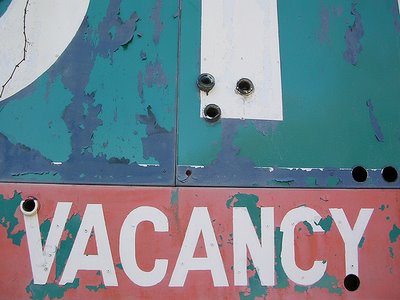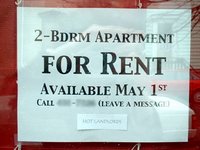We are still not sure that the great bull market in US residential real estate has come to an end. What we are sure of, on the other hand, is that it isn't at the beginning.
The great US housing bubble may be dead, but it already has a certain corpse-like stink to it. The relatives are gathered in the parlour. The silver has already been packed up. The local priest is already on the scene, administering last rites.
True, we still don't know exactly how the story will turn out. But it is time to begin preparing the obituary.
We begin, like all good requiems, in the middle of it. Or at least at one of its many comic high points.
The history of the great US house price bubble: Expensive houses
In the fall of 2006, the news appeared that Donald Trump had put his Palm Beach mansion on the market for $120 million. He had bought the place less than 10 years before for less than $50 million. If he were to get his price, the profit would be about $7 million for every year he held it. Which is good work if you can get it – earning more than half a million dollars per month – just for owning one of America's greatest beach houses.
But pity the poor next owner. He'd have carrying costs of $6 million per year ($120 million @ 5% interest), plus property taxes, plus upkeep, plus staff costs and other expenses. Instead of earning money, he'll probably be out of pocket more than a million dollars per month. And here, we let the fellow in on a little secret: houses don't go up every year, especially those that rose $70 million in the last decade.
We thought The Donald had set the pace for extravagantly-priced houses when, only a few weeks later, came news that Saudi Arabia's former ambassador to the US, Prince Bandar bin Sultan, put his ranch near Aspen, Colorado, on the market for $135 million – making it the most expensive private house ever offered for sale in America; perhaps in the whole world. But that was the charm of the housing bubble; one absurdity always seems to lead to an even bigger one later on.
And all over the world, the rich were on a spending spree. They bought ranches in South America; even the Bush family bought one – a 98,000 acre estancia in Paraguay. (In the interest of full disclosure, and a confession of partial insanity, your editor admits that he, too, bought a little spread south of the Rio Plata. He is pleased that the Bushes have chosen to locate north of the river; he was concerned for property values in his area.)
The history of the great US house price bubble: Rising prices
Rich people pulled out their fat wallets and bought diamonds...art...apartments in Mayfair...on the Place Vendome...and at the Puerto del Sol. Prices soared, as the cost of living it up headed for the moon.
But down at the other end of the income spectrum, the lower and middle classes were having a rough time. In the 10 years leading up to 2006, they had added $5.2 trillion to their debts most of it on house loans. This was nothing to worry about, said the experts. Because their net worth also had gone up. The price of the average house in America rose approximately 60% in the period. Compared to the type of gains the rich were getting in Malibu, Manhattan and Miami, a 60% gain was peanuts. But it was enough to lift the spirits of millions of ordinary people.
Besides, in the preceding 100 years nothing like it had ever happened. Normally, house prices merely followed income and GDP gains, like a good hooker, walking 10 paces behind so no one notices. But in last 10 years of Alan Greenspan's reign, they took off at a sprint and were soon racing past everyone.
A rich man can watch his property go up in price with a calm detachment, as though he were watching a beer truck overturn. But a poor man can barely contain himself. He feels he much seize the opportunity. Before you know it he is feeling a little loose and reckless. And after a while, he becomes light in the head.
Rising property prices were caused by a lie – that the feds could increase the world's purchasing power by introducing additional 'money' into the economy. Then, the lie led to a humbug after which followed a delusion trailed by a hallucination.
The history of the great US house price bubble: The idea that houses go up in value
At the centre of all these swindles was the idea that houses actually can go up in value. Readers may be taken aback. Everybody in America now knows that houses always go up in value. But it is not true. For 100 years, from 1896 to 1996, houses went nowhere at all – merely keeping up with GDP, inflation and income growth. Then, in the following 10 years – they rose remarkably.
The homeowner didn't know what to think. Predictably, he made the wrong thing of it. He came to believe that his pile of blocks, bricks, 2 x 4s and faded paint had somehow grown in real worth – like a fine wine that had aged or a bond that had matured.
This sentiment was extraordinary for two reasons. First, it was completely at odds with the evidence before his very eyes. He had only to open them to realize that his house was not, in fact, becoming a better thing. Instead, with each passing day it became a worse thing. He knew damned well that the wooden floor joists rotted and warped. The concrete foundation cracked. The aluminum windows corroded. The shingles on the roof wore away. The gutters clogged. The pipes rusted. The carpet matted down and stained. Every item - big and small – about the house actually lost value as it aged. How was it possible that the ensemble of them went up?
As the years passed, he turned the front door knob; it squeaked. He turned on the hot water in the bathroom; the faucet leaked. He turned on the air-conditioning and it sputtered and creaked. How was it possible that the aggregated collection of all these corroding, deteriorating things put together actually became more valuable? It seemed to defy reason and good sense.
But out came the theorists, the economists, and the real estate salesmen. Property was rising, he was told, because there were so many new people coming in. But how could it be that houses in the US were rising everywhere – throughout the 50 states? Where were all these new people coming from? And it was rising, they said, because the country was running out of buildable land and building codes were more restrictive. New houses were actually becoming rare; that's why older houses were so sought after.
The history of the great US house price bubble: The US building boom
But here too, he opened his eyes and saw it wasn't so. That was the second reason he might have been sceptical. Everywhere he looked, houses were going up. There was clearly a US house building boom, not merely a house price boom. In some areas, every available lot was under construction. Single family homes went up in former cow-fields and old auto lots. In other areas, single family homes were knocked down to make room for condominiums. Acres - no square miles - of previously empty land was being converted to housing.
How was it possible – with all this new supply – that prices would go up? The very idea of it contradicted his intuition if not also his instruction. Rising supplies drive prices down...not up.
What's more, these new houses had none of the defects of his old barrack. The paint was fresh. The doors opened and shut properly. The air-conditioning made no funny noises. The faucets didn't leak. The new houses were bigger, cleaner, brighter, more modern. How was it possible, in face of this competition, that his hulk of a house was going up in price? It should go down.
What was a house really worth, he might have asked himself. What is it, after all? It is shelter: it is a place to hang our hats. It is home sweet home. But who ever heard of home sweet home making anyone rich.
Then, his mind working on the problem like a gorilla trying to do long division, he realized that he had to look upon his house, not as a dwelling, but as an investment! Thus did another brick in the lunatic wall of the great housing bubble get laid in place. Between 2002 and 2006, in many areas of the country, residential housing rose at 20% per year or more. As an investment, it was actually a superb one, he noticed. What stock would do that? And what stock had granite countertops in the kitchen?
The more he looked at it as an investment, the more attractive it became. He could buy a house with no money down. That was another madness – which we'll get to in a minute. But let us imagine that he acted as a conservative, prudent investor. He could buy a $200,000 with a 20% down payment. So, he put down $40,000. Then, he got two forms of pay off. Like a stock or a bond, he got a 'dividend' – in the form of a place to live. A $200,000 house might rent for $2,000 a month. So, he figured he got $24,000 there. Plus, he got a capital gain – when the house went up in price. At 20% per year, this came to another $40,000. Whoa...what a bonanza! His $40,000 initial investment was throwing off $64,000 in 'profit' – every year. All he had to do was pay a loan of say, $1,000 a month...and, of course, property taxes and expenses.
The history of the great US house price bubble: Profiting from living in a house
One absurdity led to another; each one bigger than the last. The US householder began to see that not only was his house a great investment, but that he must be an investment genius for taking advantage of it. The average wage in the US in 2000 was only $37,565. He was making more than that – much more – just by living in his own house.
A thoughtful man, left alone with his private reflections, might have wondered how it was possible. He might have considered his own good fortune and thought more deeply about what actually lay behind it. How is money made, he might have asked himself? By work. By saving. He knew the answers. And he knew he was doing neither. Ah, by investing! 'Yes, that's it,' he said to himself, 'I am an investor, like George Soros or Warren Buffett.'
Only smarter. Buffett still lived in the same house he bought 40 years ago, he noticed. What a dolt! He should have traded up, flipped and refinanced.
Then, another monstrous delusion developed. The homeowner came to believe that he had the equivalent of an ATM machine in his bedroom. If his house was making him so much money, he said to himself, surely he could take some of that money out and spend it? Using home equity lines and refinancings, homeowners found that they could make regular withdrawals from the Bank of Their Own Homes. Borrowing against the house was easy – lenders saw little risk. And interest rates were low.
It seemed like a no-brainer. A house that was bringing $60,000 a year in wealth to a family could easily provide $10,000 to help the family live better. Heck, the family was still $50,000 ahead of the game. And so the money flowed. And what began as a trickle soon became an Amazon; a great river of no return. In the two years 2004 and 2005, homeowners 'took out' more than $1 trillion from their houses.
Experts told them they were being very prudent. They were shrewdly 'managing their household wealth,' it was said. House loans was cheap credit; better to borrow from a home equity line than a credit card. And besides, with their houses rising in price, how could they go wrong?
The history of the great US house price bubble: The ability to pay a loan
We answered that question in these pages. It was not the price of the house that counted; it was the ability of the homeowner to repay the loan. Yes, he could sell his house to get cash. But then where would he live? It wasn't as if his was the only house in America going up in price. The only way he could actually realize the inflated value of his house was by dying, or moving out of the country. Not many householders were ready to do that. Short of that, he had to service his loan, just like any other borrower. And as the weight of his borrowing increased, his legs began to wobble and buckle. Nor did it help that his house was pricier – his insurance, his maintenance costs, and his property taxes were rising too!
By 2002, US houses were clearly going up in price – faster than they ever had before. And the homeowner was about to swallow his next big absurdity.
The rise in US housing prices between 2002 and 2006 in certain markets – San Francisco, San Diego, Miami, Las Vegas, Washington, Manhattan – was breathtaking. By 2005, the average house in San Francisco was selling for $$820,482. In the Washington suburbs, ordinary split levels and colonials had doubling in price in five years' time. And along the California coast even trailers passed the $1 million mark.
The history of the great US house price bubble: Mobile home madness
In the year of our Lord, 2005, on the Pacific coast of the North American continent, a two-bedroom trailer was offered for $1.4 million. This was hardly a first or even a most. Other mobile homes had sold for $1.3 million and $1.8 million. Still another was on the market for $2.7 million.
Why would people pay so much for mobile homes? Well, the views were said to be spectacular and they were good investments. That is, they were good investments in a time when prices were going through the aluminium roofs. Still, unlike most single family dwellings, trailer owners don't own the land upon which their houses rest. Instead, they must rent it. In addition to the house loans trailer buyers have to pay 'space rent' which, for the $1.4 million mobile home was $2,700 a month. Not a fortune, but still a drain on your money.
And oh yes, we mentioned 'housing loans'...but housing loans are hard to get on trailers. Because the trailer might be pulled off the land...and then what would it be worth? Almost nothing. In Malibu, in 2005, the average house sold for $4.4 million. A trailer is a very simple home. But put it on a lot overlooking the Pacific and it is worth a fortune, at least in the great bull market of '96 to '06. The $1.4 million trailer, we were told, was in a gated community and on a 'triple-wide lot.' Wow.
Meanwhile, in Florida, buyers were taking up condos that hadn't even been built. In Miami, 'flipping' condos came to be a profitable speculation in the early 21st century. Speculators would buy a group of 5 or 10 condos – even before a single shovelful of dirt had been displaced. The idea was to sell the contract to another speculator while the place was being built. The second buyer would then sell to yet another buyer when it was completed. Neither the first, nor the second, nor the third buyer had any intention of living in the condo. They were just speculating.
The trouble was that the object of their speculation looked rather lonely and forlorn when it was finally put up. Driving by at night, you would notice that few of the condos had the lights on. Most were empty; waiting for the ultimate buyer, the poor sap who would actually live in the place and, presumably, pay for it.
The history of the great US house price bubble: Squeezing out the speculators
This eventually became such a problem for developers that they tried to squeeze out the speculators, insisting that buyers take up only one of the condos and move in within a specified period of time. In some projects, developers announced special offers, which had prospective buyers camping out all weekend in order to get a good place in line to buy when the doors opened on Monday morning.
While buyers were leaping from one absurdity to the next, they were provided special shoes...with wings...by the lending industry.
In the autumn of 2006, the regulators began to wonder. A group of regulatory agencies began to think they had allowed too many marginal buyers to take off. The air was full of them...and many were beginning to crash. Even Ben Bernanke, speaking just yesterday, warned that borrowers might need some flying lessons; a little more 'awareness' of lending practices was what was needed, said he.
Bernanke's comments followed the release of a new set of standards, in a report entitled "Interagency Guidance on Nontraditional Mortgage Product Risks."
And then, about the same time, the Comptroller of the Currency, John C. Dugan, spoke about the innovations of the mortgage industry:
"Lenders who originate these types of loans should follow sound underwriting practices that consider the borrower's repayment capacity."
Traditionally, the lender judged both his man and his market, we recall pointing out. If both were deemed solid, he would take a chance, lending the man a mortgage and hoping that the market was strong enough to allow him to recover his money if the man failed.
Nontraditionally, however, lenders didn't even bother with the man; instead, they judged the market and judged it foolproof. This proposition they then set off to test – by making outrageous loans to both fools and knaves.
The history of the great US house price bubble: Flourishing house loans
Reading the popular press – not to mention the advertisements in the popular press – we learned about the number and variety of non-traditional house loans that have flourished in the last six years. Adjustable rates, of course, became common. But so did housing loans with zero down payments, alluringly low starter rates, including interest-only mortgages, flexible payments, and 'stated income' applications in which the borrower is left to use his own imagination in describing his financial circumstances.
When the 21st century first budded out, only 5% of mortgages were of the so-called 'sub-prime' variety, that is, house loans to marginal borrowers. Five years later, one in four was to a subprime borrower.
Also in 2000, only 25% of these sub-prime house loans were of the 'stated income' variety. Only 1% consisted of 'piggyback loans' – junior loans designed to eliminate the need for a real down payment. And none were I.O., or interest only.
By September 2006, 44% of sub-prime loans had "limited documentation," 31% were piggyback loans, and 22% were I.O. This was the very moment at which regulators were asking the lending industry to be more careful – that is, after they had already let the weasels in the chicken yard.
Daily Reckoning readers laughed heartily at empty conceit; the stated purpose of both the US federal government's housing policy and that of the lenders themselves was to 'help Americans buy their own homes' or words to that effect. Easy credit was meant to increase homeownership. (Renting a house was a kind of social failure, like dropping out of high school or driving an old Pinto.) They had 'democratized' the credit market, they claimed; now not only rich speculators could lose their shirts. The common man could too!
The history of the great US house price bubble: EX credit
The obvious effect of EZ credit was to turn Americans into a race of housing speculators, not of homeowners. Instead of actually buying and paying for a house, marginal buyers were enticed into these innovative loan products, which were more like options to buy a house rather than an actual purchase of one. An I.O., interest-only, house loan gave the speculator the right to buy the house sometime in the future – if things went well. And as the I.O.'s, limited doc, flexible payment ARMs reached farther and farther into the general population of homeowners, fewer and fewer people really owned their homes at all. More and more of them became gamblers, betting that property values would rise fast enough for them to keep on refinancing until they actually pulled in enough dough to make a down payment.
The problem with this little pleasantry was that the joke was on the people who could least afford it – the gullible borrowers of the subprime market. Much more funny was the gullibility of the sub-prime lenders. Cheap suits, expensive suits – when you got down to it, they all fell for the same line of guff.
While the marginal lumpen took out ARMs, the hedge-fund, pension fund, and insurance fund geniuses bought MBSs, mortgage-backed securities. The securities were backed by the mortgages which were in turn backed by the imaginary incomes of the borrowers and inflated house prices. The credit agencies rightly judged the quality of the mortgages as less than perfect, BBB-. And then with the miraculous powers of modern finance these same mortgages were put into MBSs and turned into triple-A credits!
The transformation of bad credits into good ones, in front of the very eyes of Ph.D. mathematicians and hedge fund quants, must be rated along with Christ's performance at the marriage of Cana, where the Nazarene turned ordinary tapwater into wine. Scientists often suggest that the Gospels lie. But as to the veracity of modern finance, they were mute.
Asked to explain, the institutional salesmen resorted to a logic little different that of the ordinary homeowner. The component parts may be a little greasy, they said, but put together the sliced and diced, processed mortgage packages were less risky than individual mortgages. It was as if you were less likely to get sick from eating a can of Spam than from eating any particular cut of meat. How that could be was never explained. Presumably, the glop that went in didn't get any better by mixing it with more glop.
Just how bad some of this glop was became apparent only recently. After swindling themselves and each other for so many years, the real professionals decided their way into muscle into the house loan bubble.
The history of the great US house price bubble: A slowing market
As reported in Forbes:
"The real estate market has never offered such opportunity for graft. Since the US housing market started to soar in 2001, loan fraud has become the fastest-growing white-collar crime, according to the FBI. Last year crooks skimmed at least $1 billion from the $3 trillion US mortgage market.
"Now that the market is slowing, fraud is only rising. As business dries up, there's increasing pressure on lenders, brokers, title companies and appraisers to be profitable. That means loan and title documents aren't scrutinized as carefully as they might be, and courts - many of them so low-tech they resemble Mayberry - can't keep up with the volume of paper.
"Then there's the mad rush to sell, particularly by people who paid high prices for homes and suddenly can't afford the loans.
"It's like a tasting menu for con artists and grifters, so tempting that in some cities drug dealers have turned to mortgage fraud, plaguing lower-income neighbourhoods with crooked mortgages rather than crystal meth."
The Forbes article told the story – related here earlier this week - of a pair of thieves, known as the Bonnie and Clyde of house loan fraud. The two did very naughty things – pretending to be who they weren't, borrowing money to buy houses at inflated prices, forging documents, stealing identities, defrauding sellers and lenders alike - and made off with millions of dollars.
Elsewhere it was reported that lenders made millions in housing loans to inmates in the Colorado prison system. A whole group of miscreants issuing out of the Rocky Mountain state pen was able to buy 17 houses for inflated prices and take away $2.1 million in excess loan proceeds. According to the report, hundreds of houses were sold in what was called 'price puffs' – at prices above real market value.
By the autumn of 2006 these houses were going into foreclosure at the rate of 1 out of every 13. The price puffs began modestly – with buyers taking out $5,000 to $10,000 at the time of settlement. But amounts grew until they were walking away with 30% of the purchase price, or amounts over $100,000.
Then, the feds got on the case and people started going to jail again. But that is how these stories tend to end. In court, in chapters 7 and 11.
Every public spectacle ends in correction of some sort. Often, in a house of correction. And the force of the correction is equal and opposite to the deception that preceded it. This one ought to be a doozie.
 New homes in Canada should produce more electrical energy than they use.
New homes in Canada should produce more electrical energy than they use.





















